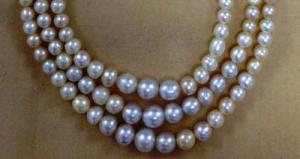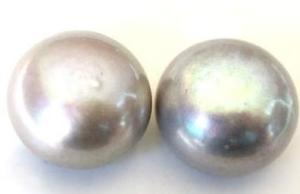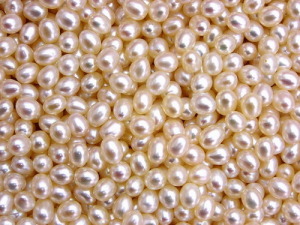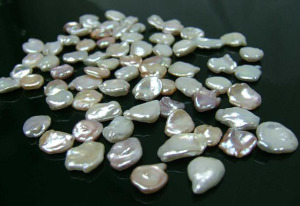Basra Pearls, South Sea Pearls, Tahiti Pearls, Akoya Cultured Pearls,
Fresh Water Cultured Pearls, Keshi Pearls
India’s love affair with pearls is without parallel in the world – an unbroken tradition of personal adornment spanning over five thousand years. From the Qutubshahi dynasty 400 years ago Hyderabad has been famous for its pearls.
Royalty…the Nizam and the Begums of Hyderabad were particularly fond of pearls and pearl jewellery. Thanks to the patronage received from the Nizam, a full-fledged pearl industry developed in Hyderabad. Businessmen and artisans migrated to Hyderabad from different parts of India. The Nizam allotted a particular place in the old city in the Hyderabad to develop their art in making pearl jewellery. Thus a full fledged pearl market developed in Hyderabad where pearls were sorted, graded, cleaned, drilled and strung in beautiful designs.
Pearl Cycle
Diving operations -> Seeding operations -> Husbandry -> Logistics -> Research & development -> Harvest -> Sorting & grading -> Design.
Diving operations:
Divers face the dangers of the Ocean depths to gather the wild shells. Today government has imposed quotas limiting the number of shells which can be taken from the wild sea.
Seeding operations: Planting the nucleus is a highly complex operation. Today’s results are testament to decades of research.
Husbandry:
Team of dedicated farmers nurture each shell through out its entire life cycle at the farms.
Logistics:
The pearl farmers are supported by significant infrastructure involving a cast of thousands from seaplanes to kitchens.
Research & Development:
Companies invest heavily in research and development which lead to major improvement in pearl farming technology.
Harvest:
Pearls are a culmination of many years of intensive work. The largest pearls demand six years of unswerving care.
Sorting & grading:
This ensures supply of good quality pearls to the clients.
Design:
The ultimate reward from the culturing process is the creation of a perfectly matched strand of pearls.
(Initially the pearls were laboriously hand drilled, today they are machine drilled)
Types of Pearls
Basra Pearls
– From the gulf of Basra in Iraq (Natural Pearls)
South Sea Pearls
– From South Pacific region…from Indonesia to Australia (Salt Water Pearls)
Tahitian Black Pearls
– From the French Polynesian region (Salt Water Pearls)
Akoya Cultured Pearls
– Japanese pearls…brand promoter Mikkimotto (Salt Water Pearls)
Fresh Water Pearls
– From China (Sweet Water Pearls)
Keshi Pearls
– They are the byproduct in culturing process (Can be both Salt Water and Fresh Water Pearls)
Basra Pearls

Basra are the most prestigious pearls. They have become rare due to pollution and industrialization of the Gulf waters.
By accident a grain of sand enters the mollusks and causes irritation. To get rid of that irritation, the oyster creates layers of nacre over it. This leads the formation of the pearl.
Out of ten thousand oysters one oyster might develop a perfect Basra pearl. This is the reason which makes Basra pearls rare and of high value. As against in China cultivated pearls in fresh water produce 20-40 pearls per oyster.
South Sea Pearls

They are grown in large tropical or semi tropical oysters.Once the oyster has been seeded it is returned to its pristine, natural habitat and left for several years for nature to do what it does best -produce layer upon layer of stunning nacre. This natural process means that each south sea pearl is unique. Some emerge perfectly round, some teardrop shaped, other semi-round, others baroque each with unique properties which set it apart from other gems cut and shaped by hand.
They have the finest quality nacre and are therefore most valuable.They are given a guarantee certificate of authenticity.They come in white, silvery blue and pale gold.
Size of south sea pearls varies from 5mm – 22mm.
(Be careful…there are lots of South Sea look alike plastic pearls in the market which are much lighter but from a distance gives the same feel).
Tahiti Pearls

Tahitian black pearls are produced by the black-lipped oysters in French Polynesia. Natural black pearls are extremely rare.
The shape, color and luster of black Tahitian pearls are natural. Colors can be light silver, gray, yellow bronze, green with pink overtone, and peacock with a natural prism of colors showing across the surface of pearls.
Akoya Cultured Pearls (Japanese Pearls)

Japanese cultured pearls are classic. They range as the most lustrous pearls. Japan cultured pearls overtone colors are rose and green. Common Japan cultured pearls colors are white, yellow, pink and cream.
Fresh Water Pearls

Fresh water pearls can be found in bays and rivers. They are cultured from fresh water mollusks. Their good price, unique shapes and colors have made them more popular in the world.
One Oyster can produce from 20 – 40 pearls…which makes these fresh water Chinese pearls very price worthy and popular.
They have different shapes, and the shapes are round, oval, rice pearls, seed pearls, baroque pearls.
Naturally they are white in color.
Other enhanced colors available are pink, peach, mauve, brown, black.
Keshi Pearls

Keshi pearls are created by mishaps in the culturing process.These small pearls are found in all sorts of colors and shapes.
Keshi are particularly lustrous and full of shimmer, or orient, since they are composed entirely of nacre.
Pearls value factor
The following 7 are GIA’S quality factors for recognizing pearls:
1. Size
2. Shape
3. Colour
4. Luster
5. Surface quality
6. Nacre quality
7. Matching
Weight Measurements
Basically there are three different measures for pearl rate:
1. Basra pearls are measured in chow.
Chow = (carat x carat x 88) divided by 135 whole divided by number of pieces of pearls of same size.
2. South sea pearls are measured by carat weight.
200 mg=1 carat
5 carats=1 gram
3. Fresh water pearls go by gram weight.
Testing of Basra Pearls
Traditionally these pearls are verified at khara kuaa, opposite Mumbai devi temple, Zaveri bazaar, Mumbai, ph. no. 022 2345 3655.
Another recommended testing is at GIA institute at Mumbai.
How to take care of your Pearls
Basra pearls should only be strung in silk thread. If strung in gold wire the hole of the pearl gets enlarged over a period of time which in turn reduces the value.
Basra pearls should be stored (especially in lockers) with a few seeds of Isabgol. This prevents discoloring and allows the pearl to breath.
Wear pearls only after applying hair spray, perfume, and makeup to avoid discoloration of pearls due to chemical reactions.
Wipe pearls with the soft muslin cloth before storing
Store pearls wrapped in a soft cloth to protect rubbing against other jewellery.
Restring pearls occasionally depending on the frequency of wearing them.






